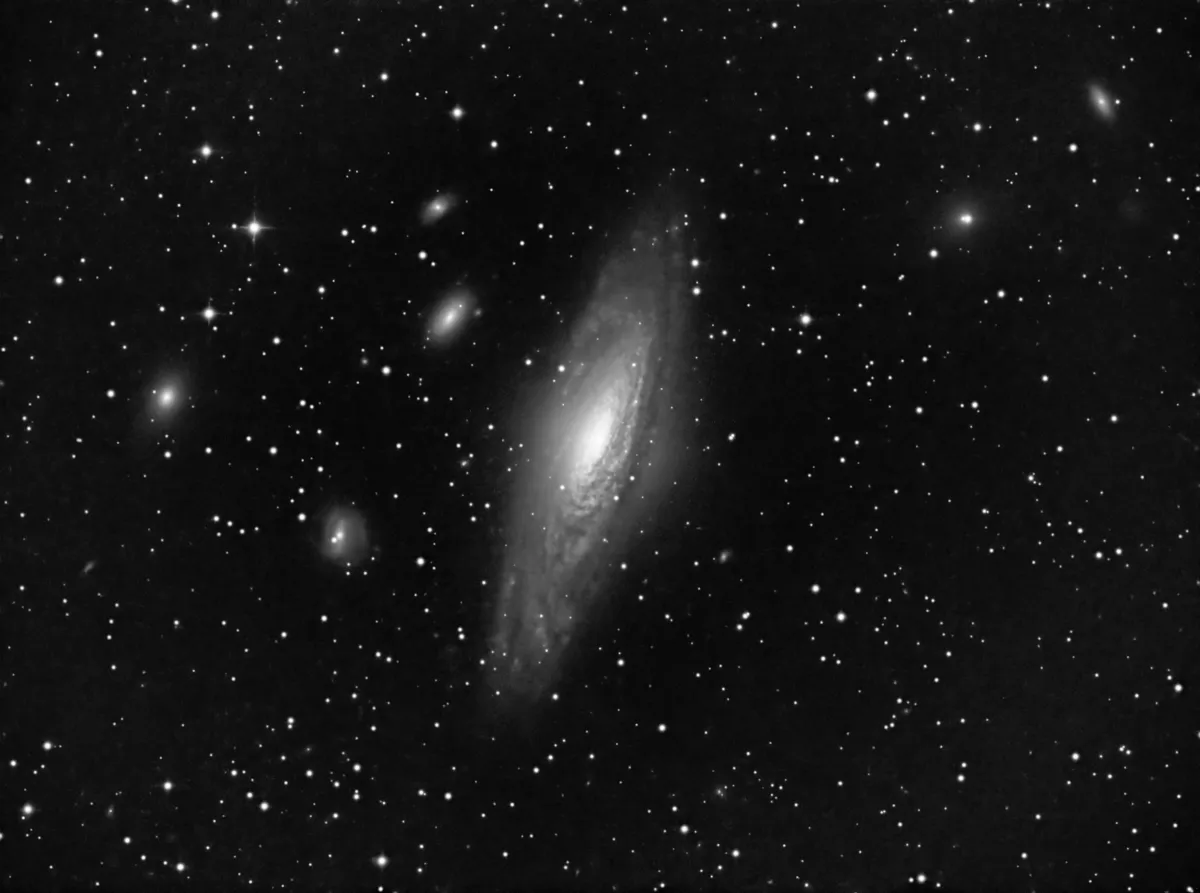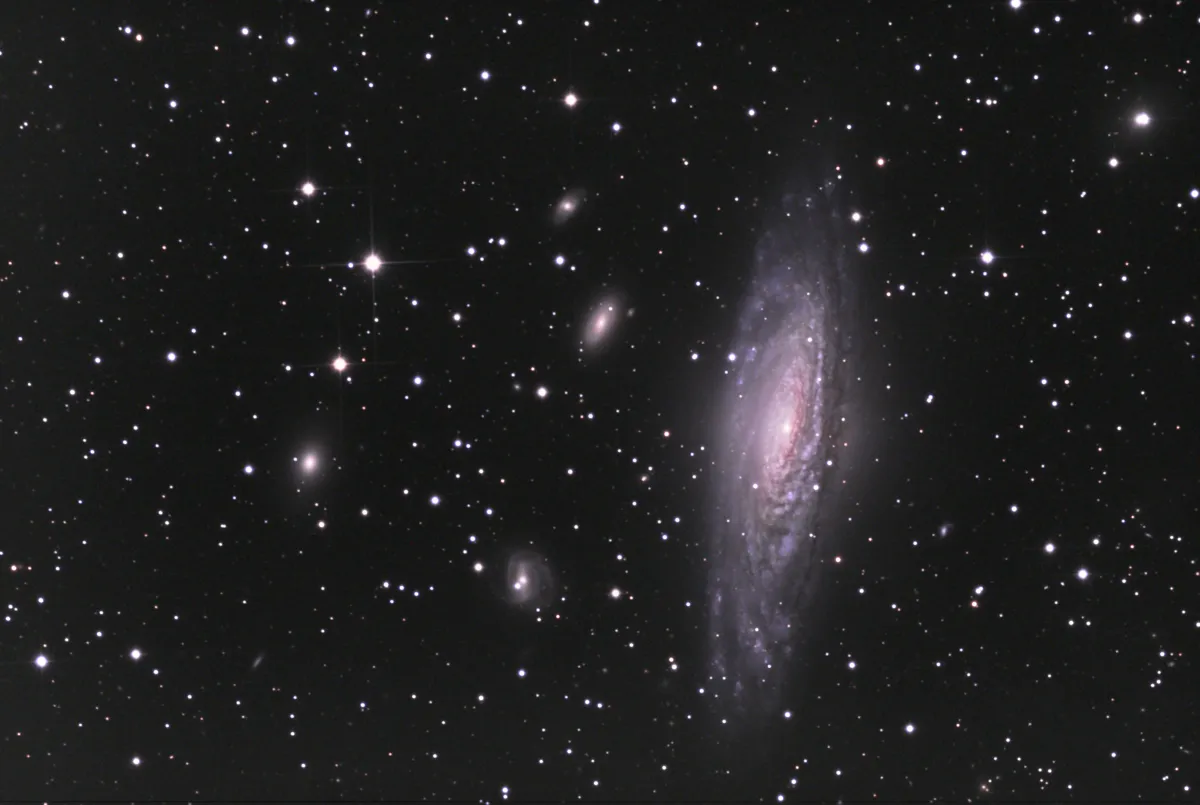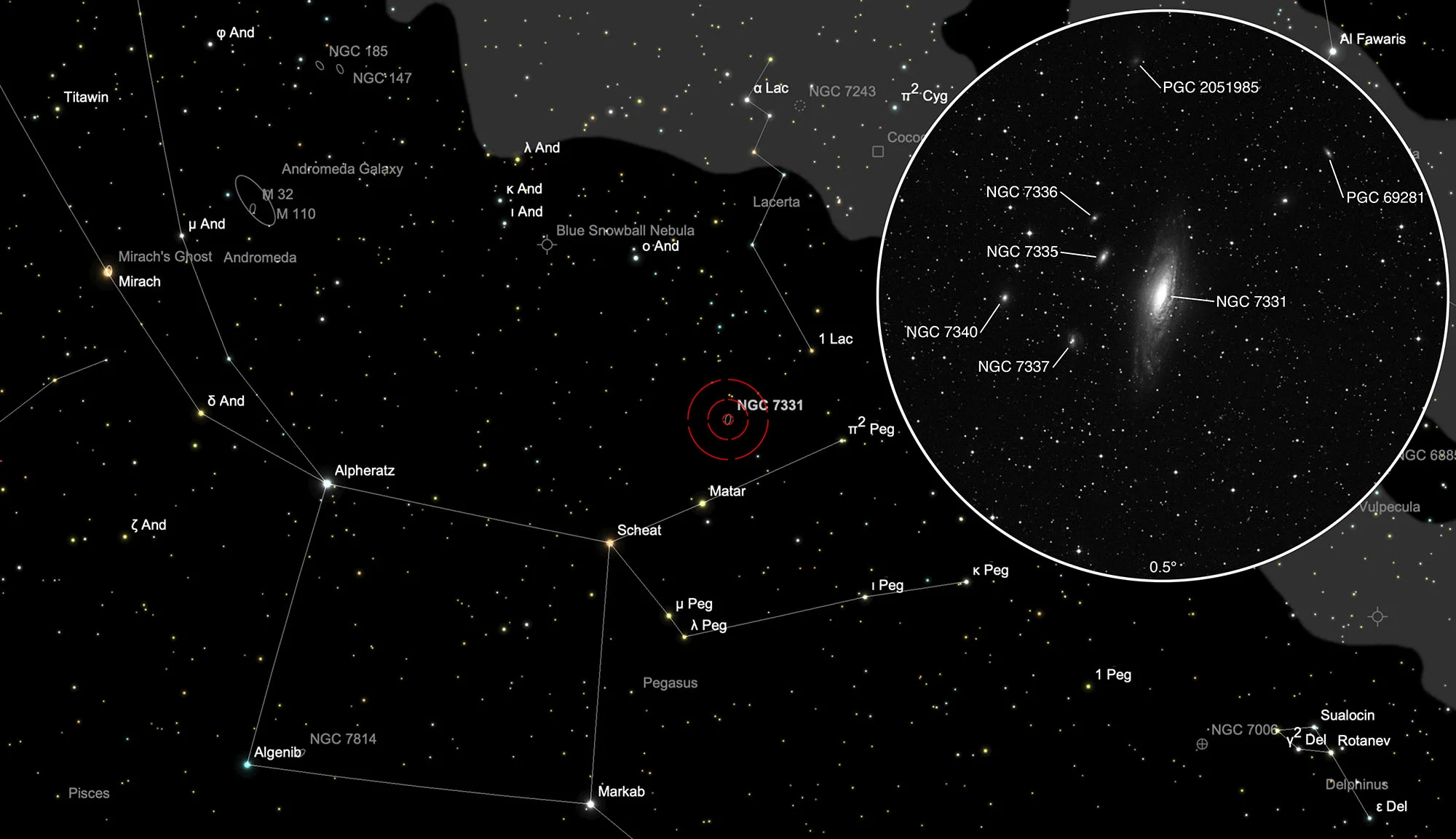NGC 7331 Galaxy Group



Galaxy NGC 7331
This galaxy was discovered by William Herschel on 5 September 1785 using his 18.7 inch reflector. He cataloged it as I 53 and noted: «Very bright, considerably large, much extended, much brighter in the middle, resolvable.» [463]
Given distances for NGC 7331 range from 12.8 Mpc to 16.2 Mpc (41 to 53 million light years). With a diameter of 120'000 light-years, it is about the same size, shape and mass as our Milky Way, and has a similar rate of star formation. But unlike our Milky Way, NGC 7331 is not a barred spiral, but a spiral galaxy of morphological type SAb and with a LINER-type active core. [145, 196, 205]
| Designation | NGC 7331 |
| Type | Gx (Sbc) |
| Right Ascension (J2000.0) | 22h 37m 05.1s |
| Declination (J2000.0) | +34° 25' 13" |
| Diameter | 10.2 × 4.2 arcmin |
| Photographic (blue) magnitude | 10.4 mag |
| Visual magnitude | 9.5 mag |
| Surface brightness | 13.3 mag·arcmin-2 |
| Position Angle | 171° |
| Redshift (z) | 0.002722 |
| Distance derived from z | 11.50 Mpc |
| Metric Distance | 13.940 Mpc |
| Dreyer Description | B, pL, pmE 163°, smbM |
| Identification, Remarks | WH I 53; h 2172; GC 4815; UGC 12113; MCG 6-49-45; CGCG 514-68 |
Galaxies NGC 7335, 7336, 7337, 7340
The radial velocities, which are a factor of seven to ten higher, reveal that these galaxies are not companions of NGC 7331, but that they are much further away, namely 304 to 414 million light years. They just happen to be in the same line of sight. Apparent magnitudes are around 15 mag. [145]
| Name | RA | Dec | Type | bMag | vMag | B-V | SB | Dim | PA | z | D(z) | Dreyer Description | Identification, Remarks |
|---|---|---|---|---|---|---|---|---|---|---|---|---|---|
| NGC 7335 | 22 37 19.5 | +34 26 54 | Gx (S0-a) | 14.4 | 13.3 | 1.1 | 13.0 | 1.2 × 0.6 | 151 | 0.021065 | 88.98 | vF, vS (B of Ld R) | WH III 166; h 2174; GC 4823; UGC 12116; MCG 6-49-47; CGCG 514-69; NPM1G +34.0449 |
| NGC 7336 | 22 37 21.9 | +34 28 56 | Gx (S) | 15.3 | 14.5 | 0.8 | 13.1 | 0.8 × 0.4 | 139 | 0.029354 | 123.9 | eF, vS (C) | GC 4816; MCG 6-49-49; NPM1G +34.0450 |
| NGC 7337 | 22 37 26.6 | +34 22 26 | Gx (SBab) | 15.2 | 14.4 | 0.8 | 14.0 | 1 × 0.8 | 177 | 0.021952 | 92.72 | eF, S, stellar (E) | GC 4817; UGC 12120; MCG 6-49-50; CGCG 514-71 |
| NGC 7340 | 22 37 44.1 | +34 24 38 | Gx (E?) | 14.7 | 13.7 | 1.0 | 13.0 | 0.9 × 0.6 | 162 | 0.021348 | 90.17 | vF, vS, (D of Ld R) | GC 4818; MCG 6-49-52; CGCG 514-75; NPM1G +34.0452 |
Finder Chart
NGC 7331 is located in the constellation of Pegasus and is most often used as a starting point for Stephan's Quintet. On 31 August it is in opposition to the Sun and crosses the meridian at local midnight.
Visual Observation
320 mm aperture: NGC 7331 appears as an elongated, oval galaxy. With 9.5 mag it offers a good brightness to be found with a small and medium-sized telescope. The four neighboring galaxies are of interest to larger amateur telescopes. NGC 7336 is the smallest of the four companion galaxies. The brightnesses are 14.7 mag for NGC 7335, 14.9 mag for NGC 7340, and the two faint companions NGC 7336 and NGC 7337 each have 15.4 mag. These galaxies are truly a test of sky transparency and a 12.5 inch telescope. — 12.5" Ninja-Dobson, F:4.5 / TV-Radian 8mm, 181x, 0.33, 2005, Eduard von Bergen
762 mm Aperture: Of the Pegasus galaxies, NGC 7331 is the most striking. It usually serves as a starting point for locating Stephan's Quintet, although it is well worth taking the time to observe NGC 7331 itself and its companions in detail. The left side of the main galaxy NGC 7331, facing away from its companions, has a dark border, while the right side fades out brightly. Of the four companions mentioned here, NGC 7335 is the easiest to see. NGC 7340 lies in line with two stars and is therefore impossible to miss. The galaxy NGC 7337 lies in a star formation and can only be recognised there as a blurred, puffy ‘star’. NGC 7336 is the smallest and faintest galaxy and only really became noticeable when the Dobsonian was moved slightly. — 30" f/3.3 SlipStream Dobsonian, Hasliberg, 18. 12. 2025, SQM-L 21.07, Eduard von Bergen
